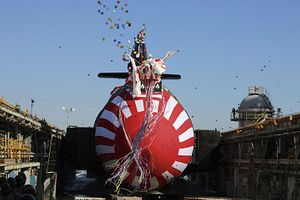Kawasaki Heavy Industries (KHI) has launched the 12th and final Soryu-class diesel-electric attack submarine (SSK), the future JS Toryu (pennant number SS 512), during an official ceremony held at the company’s shipyard in Kobe in Hyogo Prefecture on November 6. It is the second Soryu-class SSK equipped with lithium-ion batteries that reportedly store considerably more power than the lead-acid batteries installed on the other 10 boats of the class.
The Toryu, laid down in January 2017, is the sixth Soryu-class SSK and the 28th boat overall to be constructed by KHI since 1945. The remaining six SSKs of the class were built by Mitsubishi Heavy Industries (MHI). Construction costs of the new submarine are estimated at around $496 million. The Toryu is expected to be commissioned in March 2021, with the 11th SSK, the future JS Oryu, to enter service with the Japan Maritime Self Defense (JMSDF) in March 2020.
The Toryu and Oryu, the latter of which launched in October 2018, will both be equipped with lithium-ion batteries making Japan the only known country to have fitted this technology into a submarine. The new batteries will reportedly enable the submarines to shut off their diesel-electric propulsion and operate on battery power alone for longer periods under water. Batteries make less noise than diesel-electric engines and as a result reduce the submarine’s acoustic signature making detection harder.
Soryu-class SSKs are also the first submarines of the JMSDF to be equipped with air-independent systems, as I explained previously:
The 4,200-ton (submerged) Soryu-class boats are the JMSDF’s first SSKs to be fitted with air-independent propulsion (AIP) systems, enabling the submarines to stay underwater for up to two weeks. (…)
Soryu-class SSKs are powered by two Kawasaki 12V 25/25 SB-type diesel engines and four Kawasaki Kockums V4-275R Stirling AIP engines for silent running. The boats have an estimated range of 6,100 nautical miles (11,297 kilometers) with a maximum surface speed of 13 knots and a subsurface travelling speed of 20 knots. The maximum diving depth of the sub is around 650 meters.
The Soryu-class is fitted with six HU-606 533 mm torpedo tubes that can accommodate Type 89 heavyweight homing torpedoes and UGM-84 Harpoon anti-ship missiles. Next to bow-and-flank-mounted Hughes/Oki ZQQ-7 sonar arrays, the sub is also equipped with a towed array sonar capable of detecting ships over 70 kilometers away.
Additionally, I noted:
The Soryu-class boats’ hydrodynamic design is based on the older Oyashio-class diesel-electric attack submarines currently in service with the JMSDF. It is (…) fitted with a computer-controlled, Swedish-designed X rudder to increase the submarine’s maneuverability when operating in shallow waters close to the seabed.
To date, 10 Soryu-class SSKs have been deployed with the JMSDF. The service also operates 11 Oyashio-class SSKs two of which have been converted into training submarines.

































